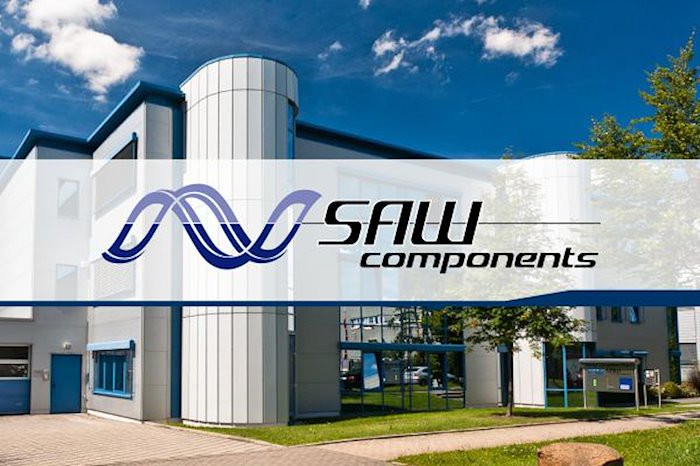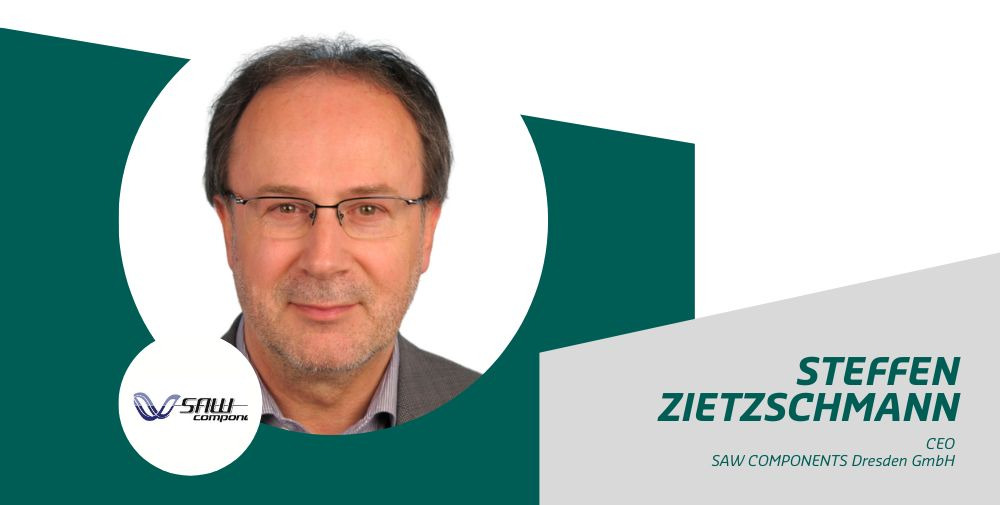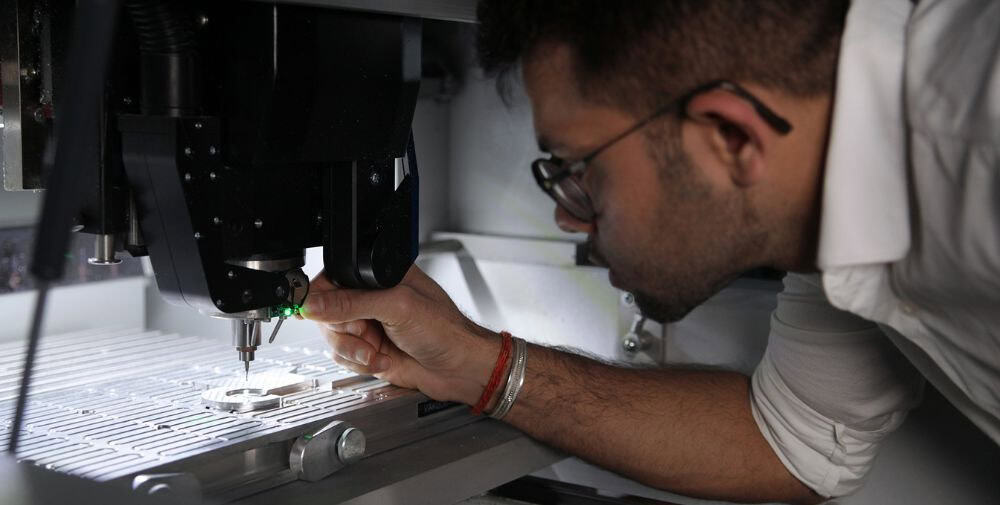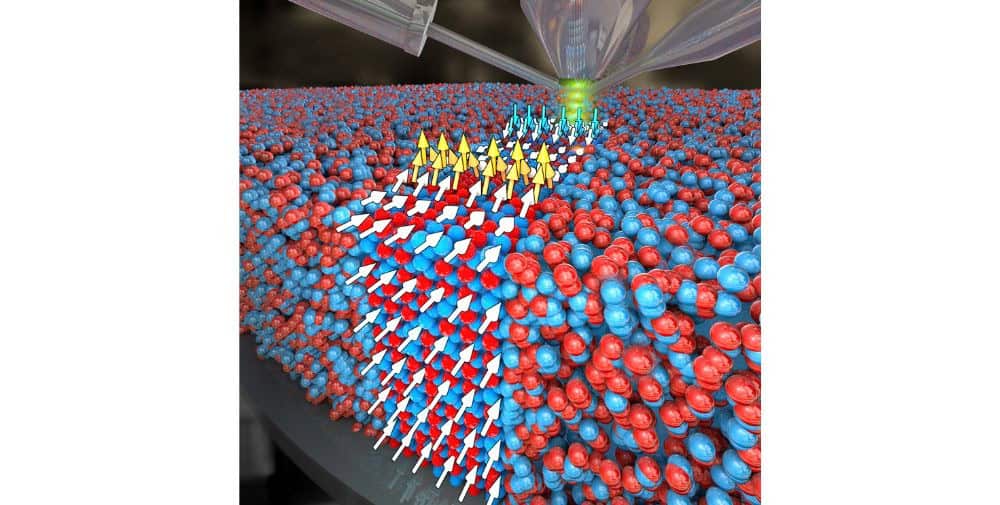But before that, let’s take a brief look at SAW COMPONENTS.
- Date of opening: 1993, established as a limited liability company in 1996
- Number of production sites worldwide: 1
- Initial investment cost: 2 million euros
- Factory size (area): 4000 m²
- Size of clean room(s): 1,800 m²
- Produced structure sizes: 250 nm
- Number of wafers produced per year: 20,000
- Size of wafers: 100 mm, 150 mm, 200 mm
- Application industries (top 3): Mobile communications industry, sensor technology, bioanalytics
- Number of employees: 33
- Number of nationalities: 7
- Proportion of women: 40%
- Skilled workers sought (top 5): Physicists and similar scientific professionals, Application Engineer:s, Operators, SAW Chip Designer:s, Engineer:s in frontend and backend
- Skills Wanted (Top 5): scientific knowledge, independent, determined way of working, ability to communicate and work in a team, creativity and analytical skills, flexibility

© SAW COMPONENTS Dresden GmbH
Mr. Zietzschmann, what is the importance of the Dresden location for you?
As an SME with over 25 years of history, SAW COMPONENTS is one of the oldest chip factories still operating in Dresden. To this day, the city remains the central administration and production site where all manufacturing takes place, even though the customer structure has changed completely from domestic customers to an international orientation with over 90% export quota since the company was founded.
In which specific areas have investments been made since the opening and how high were these investments in total?
We are continuously investing in new technologies and opportunities. Historically, the largest single investment was the construction of the factory on the Manfred-von-Ardenne-Ring and the conversion to i-Line lithography in the mid-2000s. However, we are also currently investing heavily in trim technology, dry-film resist packaging, lithography and thin-film equipment, as well as the development of our bio-sensor division.
For what uses does the Dresden site produce? What exactly can the chips produced do and in which sectors/industries are they used?
Our SAW chips are used in a wide range of applications in mobile communications (RF front-end filters) – especially in smartphones – in industrial radio applications as well as in aerospace and, to a rapidly increasing extent, in wireless sensor systems. As completely passive components, they are used in sensor technology as battery-free and at the same time wireless radio sensors for the measurement of diverse measurands such as temperature, strain, torque, for ID identification and furthermore also for the analysis of biological, medical and chemical samples.
There are now five Fabs, numerous supplier companies and research institutions as well as microelectronics-relevant software companies in Saxony. In which areas is the network particularly important for your company?
We maintain long-standing close relationships with many other chip manufacturers and supplier companies in the region. In addition to the important infrastructure, the supply of spare parts and raw materials, this also involves joint projects and technical cooperation.
Are there any specific cooperation projects here with other players at the site, and if so, which ones?
There are with several partners at the site, and as is so often the case in our industry, they are not public. We work closely together in the areas of basic research, production services, manufacturing and in the procurement area.
The topic of skilled workers is not only of concern to us. Currently, Saxony’s ICT sector is growing by around 5,000 skilled workers per year, which equates to over 100,000 skilled workers in 2030 if growth remains constant. What role does direct proximity to other fabs play in the context of your skilled workforce strategy? Does it tend to make the location more attractive or the competition greater?
Both are noticeable factors. The size of the industry attracts many interested people to Dresden. There is a continuous fluctuation between the Fabs, which always creates new opportunities. At the same time, as the smallest of Dresden’s Fabs, we struggle to be visible to these people and draw attention to ourselves so that we can engage in conversation and make our attractive offers.
Intel is planning a so-called mega-Fab with Magdeburg. What impact will this have for you in terms of supply chains, service providers, raw materials and also skilled workers?
We are hoping for the settlement of further suppliers and service providers in the central German region and a further increase in the attractiveness of the region for national and international skilled workers. At the same time, we can certainly assume that competition for skilled workers will continue to intensify.
What is your vision for the location? How would you like to develop it further?
Currently, we are already in the process of expanding production capacity at our fab in Dresden. Our vision is to make SAW COMPONENTS the cross-industry platform for thin film technology and lithography. We are evolving away from being a pure SAW device manufacturer to a certified producer of nanostructures on wafers, micro-optics products, medical production and anything else customers want to produce on the special, glass-like and piezoelectric wafers.
What are concrete support measures that are necessary on the way to this vision?
The most urgent issue at the moment is undoubtedly the containment of skyrocketing electricity prices. Especially for a small fab, the current developments are difficult to cushion and cannot be passed on to the products on the international market. In addition to this current issue, support for forward-looking innovations and improving science education are crucial.
Thank you for the interview, Mr. Zietzschmann.
__________________________________________________________________________________________________________________________________
This interview was first published as part of our magazine NEXT “In Focus: Microelectronics”. All other interviews of the Saxon semiconductor plants can be found in the complete edition.
👉 To the complete issue of the magazine




